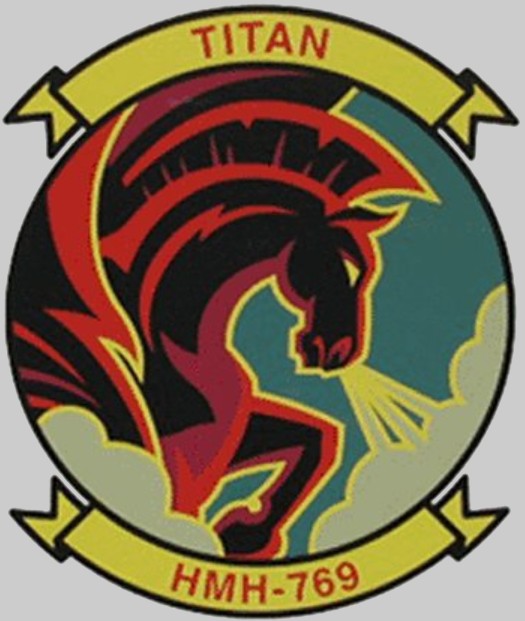 |
||||||
|
HOME
|
US Navy -
ships
|
US Navy - air
units
|
USMC - air
units
|
International
Navies
|
Weapon Systems
|
Special Reports |
||||||
|
|
||||||
|
|
||||||
|
US Marine Corps - Marine Heavy
Helicopter Squadron 769 HMH-769 'Titan' |
||||||
|
|
||||||
|
||||||
| 05/24 | ||||||
|
||||||
|
|
||||||
| images | ||||||
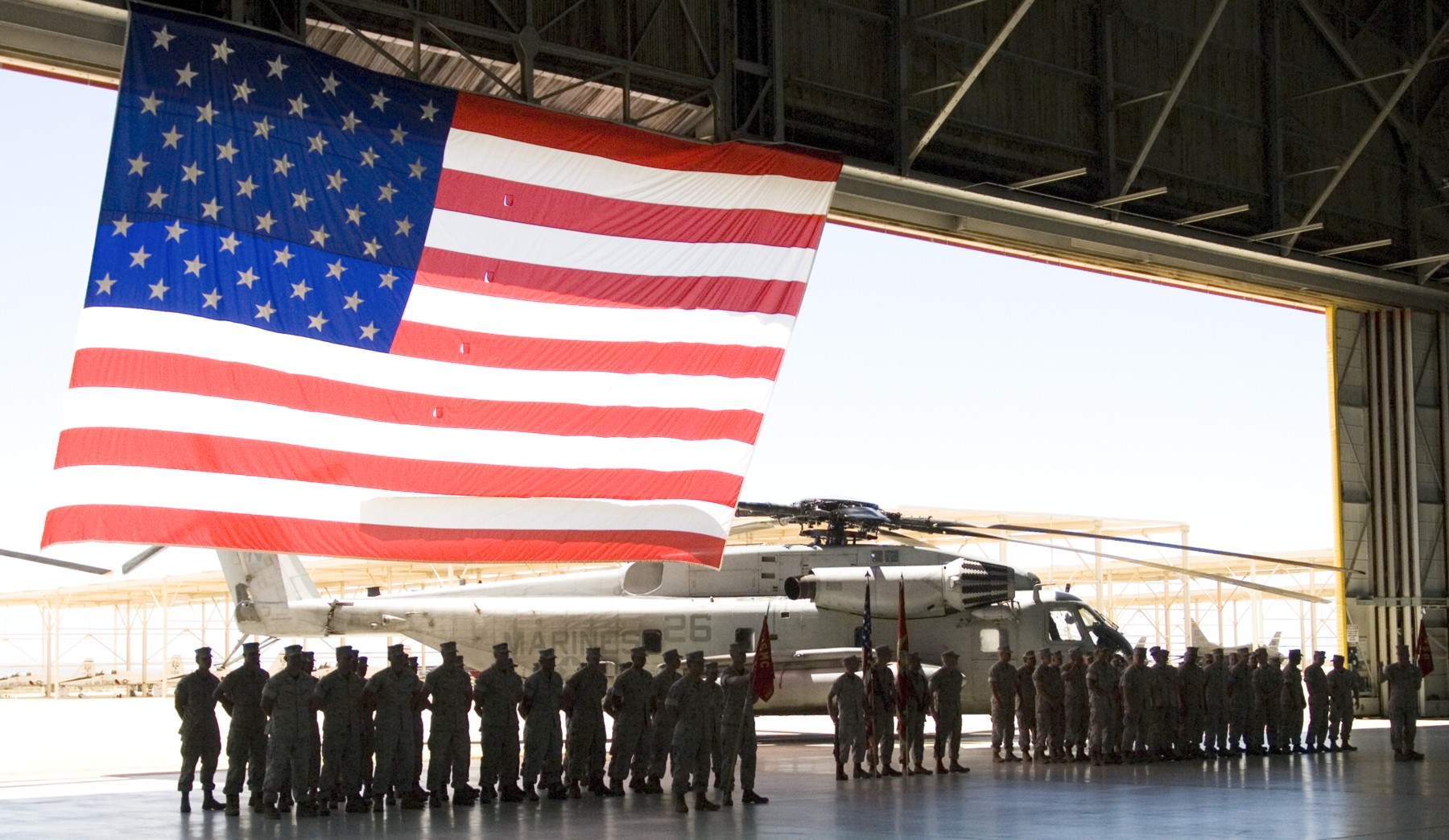 deactivation ceremony at Edwards AFB, California - August 2, 2008 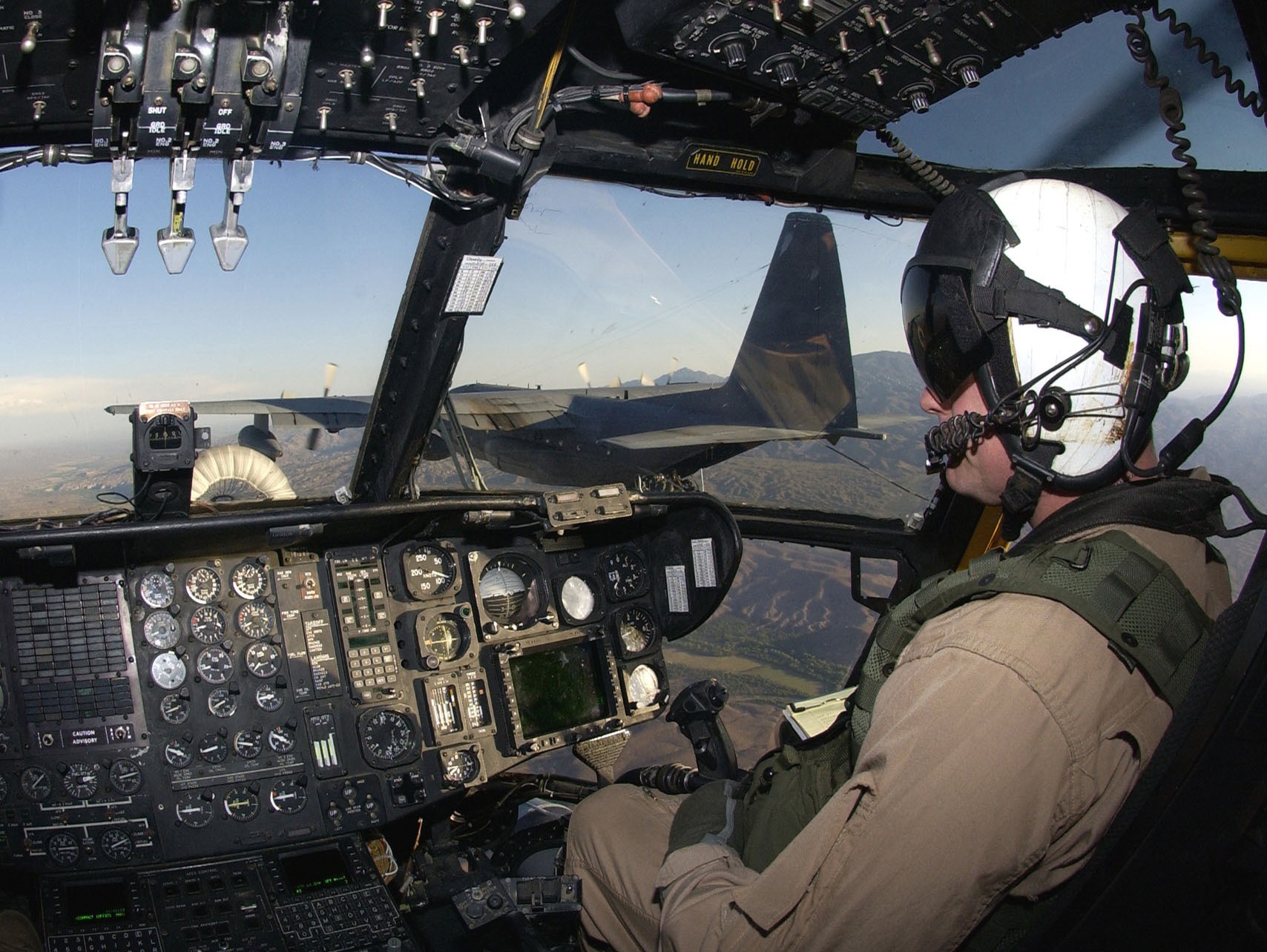 Sikorsky CH-53E Super Stallion (HMH-769) - 2003  Sikorsky RH-53D Sea Stallion (HMH-769) aboard USS Inchon (LPH 12) - 1986 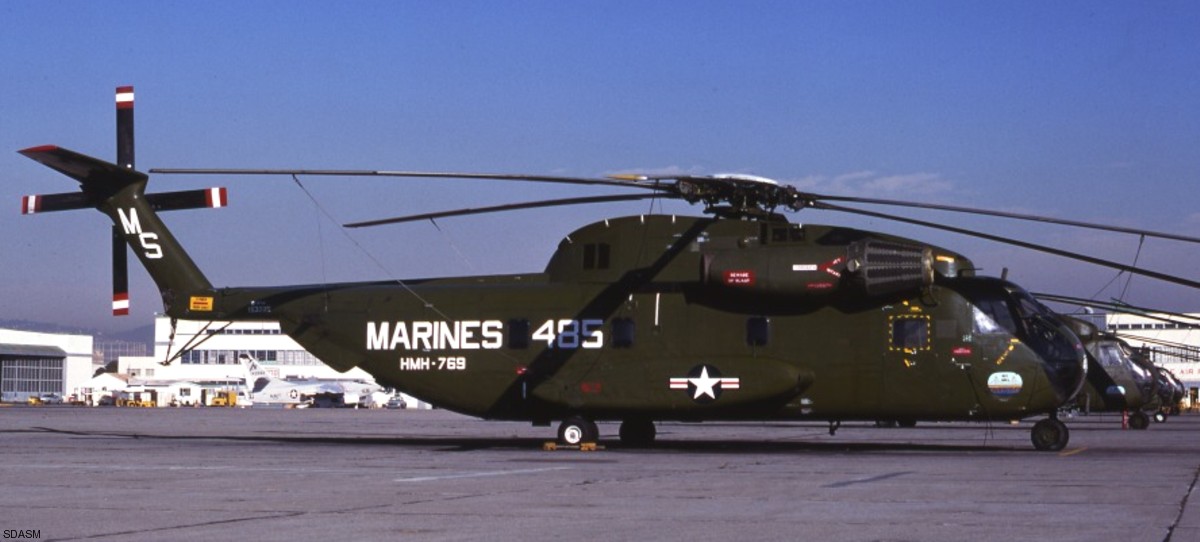 Sikorsky CH-53A Sea Stallion (HMH-769) at NAS Alameda, California - October 1977 (San Diego Air & Space Museum image) 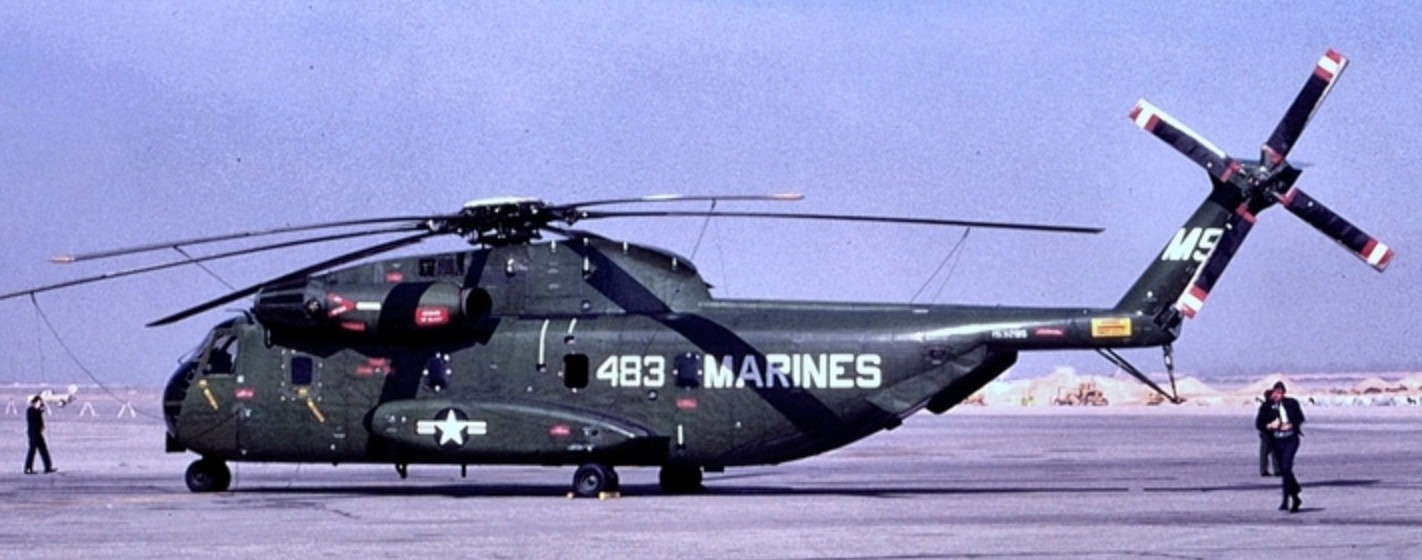 Sikorsky CH-53A Sea Stallion (HMH-769) - undated |
||||||
|
|
||||||
| history | ||||||
|
HMH-769 was originally activated as Marine Helicopter Transport
Squadron (HMR) 769 on April 15, 1958. Based at Naval Air Station
Oakland, CA, HMR-769 flew the compact single radial engine, twin
overlapping rotor utility helicopter developed and produced by
Piasecki Helicopter Corporation. In April 1959, HMR-769 transitioned to and began flying the Sikorsky built HSS-1/SH-34G. On April 1, 1961, HMR-769 was redesignated Marine Medium Helicopter Squadron (HMM) 769 and relocated to Naval Air Station Alameda, California in July of that same year. The squadron continued to fly the H-34 until 1971 when it transitioned to the Sikorsky built CH-53A "Sea Stallion" and on September 1, 1971, was redesignated Marine Heavy Helicopter Squadron (HMH) 769. The squadron remained HMH-769 until June 1, 1980 when it was deactivated. The squadron's remaining personnel and aircraft were then consolidated into the other Marine Reserve Heavy Helicopter Squadron, HMH-772, redesignated HMH-772 Detachment A and given the callsign "Roadhogs". In April 1990, HMH-772 Detachment A became the first Marine unit to transition to and fly the former minesweeper RH-53D. With its minesweeping gear removed, the RH-53D proved to be a powerful replacement to the aging CH-53A airframe. On November 27, 1990 HMH-772 Det A was activated and deployed to Saudi Arabia in support of combat operations for Operations Desert Shield/Desert Storm and served under Marine Aircraft Group 26. HMH-772 operated from Al Jubayl and the expeditionary combat base "Lonesome Dove" while supporting the assault. Upon conclusion of hostilities in the Persian Gulf, HMH-772 Det A embarked aboard the USS Tarawa (LHA 1) for the return to CONUS. While en route, the Roadhogs were called upon to provide humanitarian assistance and disaster relief (HA/DR) to the country of Bangladesh during Operation Sea Angel. On 1 April 1993, HMH-772 Det A was redesigned as HMH-769. On May 1, 1996, the Roadhogs relocated from NAS Alameda to Marine Corps Air Station El Toro, California. While there, the squadron received its first CH-53E "Super Stallion" on August 23, 1996, replacing its aging RH-53D with the newer, more powerful airframe. In July 1998, the Roadhogs were the recipient of the Marine Corps Aviation Association's 1998 Pete Ross award for 4th MAW safety. On May 1, 1999, the Roadhogs relocated to Edwards Air Force Base located in Rosamond, California. In July 2001, the Roadhogs were the recipient of the Marine Corps Aviation Association's 2001 Pete Ross award for 4th MAW safety. The Roadhogs were activated for a third time on January 27, 2002 and deployed two aircraft and 17 Marines with the 11th Marine Expeditionary Unit (SOC) to Djibouti in the Horn of Africa; detachment commanded by LtCol Jeff Freeman. This deployment marked the first time that a reserve squadron augmented an Active Forces MEU. Activated for their final time on January 5, 2004, the Roadhogs commanded by LtCol Rick Mullen deployed in March of that same year to Bagram air base, Afghanistan for seven months in support of Combined Joint Task Forces 180/76 for Operation Enduring Freedom 4 and 5. Midway through their deployment to Afghanistan, the Roadhogs were selected as the Marine Corps Aviation Association's 2005 Keith B. McCutcheon Marine Heavy Helicopter Squadron of the year. On April 2, 2007, Headquarters Marine Corps directed the deactivation of HMH-772 Det A, with a completion date of no later than September 2008. The following year saw a flurry of activity as the squadron marched toward this milestone, transferring aircraft and personnel consistently throughout the year while still maintaining a rigorous schedule. On July 23, 2008, aircraft 45 commanded by Major Jodi Maroney departed Edwards AFB for MCAS New River. Major Maroney and her crew arrived MCAS New River on July 27, 2008. On the night of Saturday March 22, 2008, the Roadhogs began their last Annual Training period by executing section High Level Light (HLL) Night Vision Device (NVD) Confined Area Landings (CAL) in the local training area. Upon the section's return to base, the aircrew were informed that there was an injured climber located approximately 90 miles north on Mount Whitney. The aircrew gathered and reviewed all available information to include location and weather. After conducting deliberate planning and briefing the hop, the aircrew boarded their aircraft and took off for the injured climber. Once airborne, the aircrew flew direct to Lone Pine Airport, landed and conducted a face-to-face brief with the ground rescue coordinator. When complete with the brief, the aircraft took off and headed direct for the 12,000 MSL plus landing zone (LZ) that had been identified by rescuers at the injured climbers location. With both aircraft climbing to 14,000 MSL, the section was able to identify the LZ due to GPS coordinates and the headlamps that the ground rescuers were wearing. As lead started setting up to land, dash 2 remained in the overhead to provide coverage and radio relay. After lead had been in the LZ for roughly 15 minutes, the aircraft departed the LZ with the injured climber aboard and both aircraft returned to Lone Pine Airport to execute the patient transfer to civilian medical services. Once transfer complete, both Roadhog aircraft took off from Lone Pine and headed south to return to Edwards AFB landing around 0300. Due to the quick actions and professionalism of the aircrew, the injured climber reportedly survived his traumatic injuries. On Monday July 14, 2008, the Roadhogs launched their last two aircraft (section led by Col. Phillips) from Edwards AFB for MCAS New River, NC. On Friday, July 18, 2008 the section landed at MCAS New River, where the aircraft were transferred to HMH-461, Marine Aircraft Group 26, 2nd Marine Aircraft Wing. On August 2, 2008 at 1200, HMH-769 was deactivated at Edwards AFB. - - - - - USMC press release, published January 23, 2008 By Senior Airman Julius Delos Reyes, 95th Air Base Wing Public Affairs Marine HMH-769 squadron begins deactivation process EDWARDS AIR FORCE BASE, Calif. -- The Marine Aircraft Group 46 Detachment Bravo is scheduled to deactivate its Marine Heavy Helicopter Squadron 769 in the late summer as part of the 2007 Marine Corps Aviation Plan. The aviation plan is a consolidated action plan that provides an overview of Marine aviation total force organization, aviation readiness and planned organization aircraft and equipment transitions over the next 10-year period. "Ultimately, they are going to make a smaller force that will provide the same mission but less aircraft and people," said Sgt. Maj. Michael Brookman, MAG 46 Det. B's highest enlisted Marine. "They are trying to get the aircraft either to the active forces or to the retirement yard." MAG 46 Det. B includes HMH-769 and Marine Heavy Helicopter Squadron 764. HMH-769 is responsible for CH-53E Super Stallion transport helicopters, while HMH-764 manages CH-46E Sea Knight transport helicopters. HMH-769 is scheduled to ship out its CH-53 helicopters gradually, said Lt. Col. Thomas McCarthy, MAG 46 Det. B commanding officer. About 65 reservists and 90 active-duty Marines within the squadron will be impacted by the deactivation. "The (squadron has) already started moving some of its aircraft," Colonel McCarthy said. "By the end of July, all of the CH-53 aircraft will be gone from Edwards." The MAG 46 Det. B will be focusing on helping HMH-769 with its equipment and personnel during August and September time frame, he said. "As far as the active-duty Marines, they will begin to move this summer wherever they are needed," Colonel McCarthy said. "Some of them have already moved, and we are not receiving replacements." This is just another permanent change of station move for the active-duty Marines, he said. The ones who are impacted the most with this transition are the reservists. For the Marine reservists, some will be transferred to the HMH-764 squadron, Colonel McCarthy said. They also have the option to get out of the Reserves, find another military occupational specialty or transfer to another unit. Meanwhile, MAG 46 Det. B here will continue to perform its function, Sergeant Major Brookman said. "The Detachment Bravo's mission is to provide administration and supply support," he said. "We still have one squadron here, so our role is not going to change." The HMH-769 deactivation will also mean a reduction of people within the detachment since they will be only be focusing on HMH-764, Sergeant Major Brookman said. "Hopefully, this is going to be a smooth process," he said. "We have been planning this deactivation for about a year now. It is a lot of work to get from today until the HMH-769 deactivates." source: wikipedia + US DoD 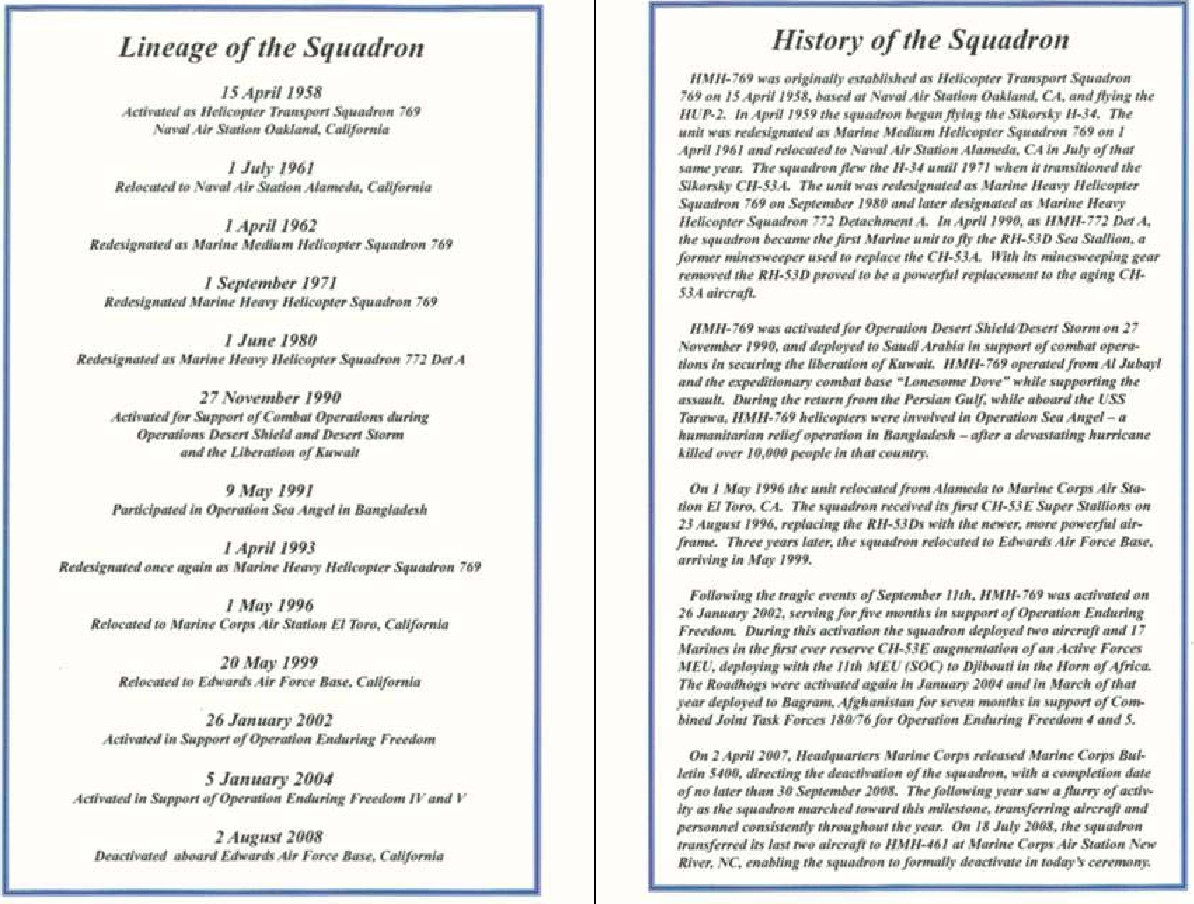 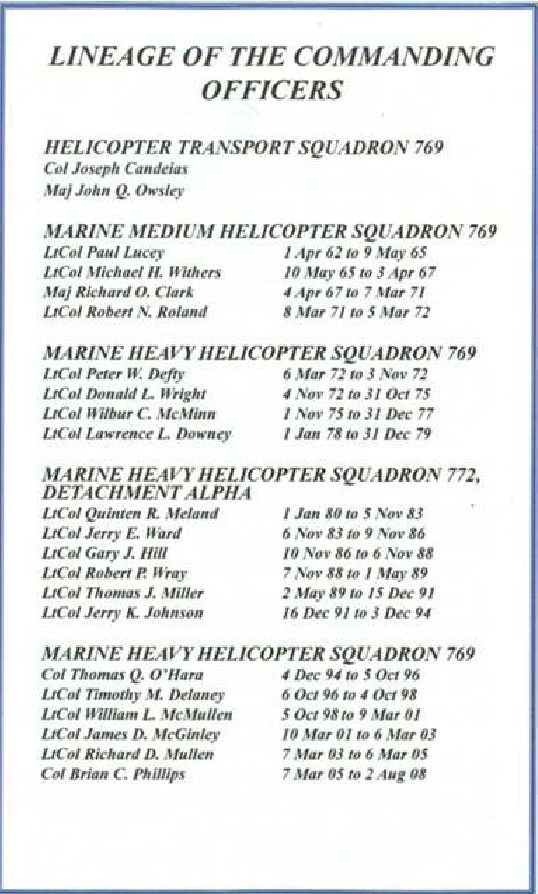 |
||||||
|
|
||||||
| patches + more | ||||||
|
|
||||||
| | seaforces.org | US Marine Corps Air units start page | |
